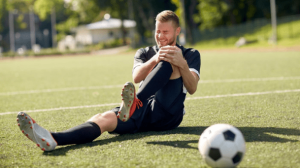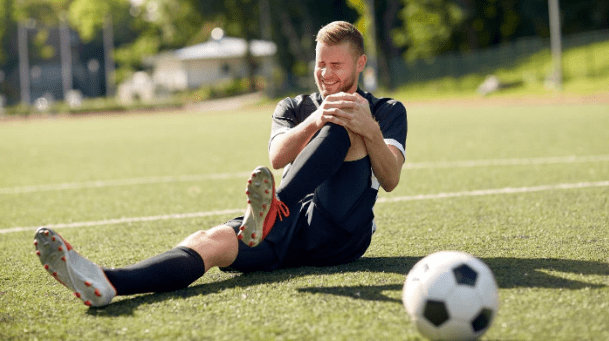
You’ve probably been there before; I know I have. An audible pop, crack, or pulling sensation followed by sharp pain, loss of motion, and fear of what just happened. You don’t want to believe it, so you attempt to make another movement and the pain increases. Your body is telling you to stop and protect, while your brain is saying this can’t be happening, I have too much going on to stop and rest. I need to push through it. Or, at least, that’s what goes through my mind when experiencing an injury. All in all, sports injuries are no fun. They take away time and money and can create fear and uncertainty that can last far longer than the injury itself.
When returning from an injury, a lot of my patients or clients tend to underestimate the amount of time it will take for them to resume activity. Sometimes, against my advice they return too soon, which in the end can backfire and lead to more downtime and waiting on the injury to heal. Here are some quick tips to help you prevent that from happening and get back to activity in a safe and effective way.
Wisdom is Knowledge
Wisdom is the ability to discern and judge which aspects of that knowledge are true, right, lasting, and applicable to your life. … In a nutshell: If knowledge is information, wisdom is the understanding and application of that knowledge and insight is the awareness of the underlying essence of a truth. Deep stuff here… In short, the more you know about your injury, the better you can manage it. Check with your doctor (MD), physical therapist (PT), or athletic trainer (ATC) to help you determine what you are dealing with, how long it will likely take to heal, and the best way to manage it.
Slower can be Faster
I’ll be honest, even though I’m a Certified Athletic Trainer and know better, I’m stubborn when it comes to waiting for injuries to heal. I love to lift weights and hate anything that kills my gains. However, if an injury does occur, I know I can get back to lifting sooner if I allow adequate time for the injury to heal. Instead of trying to push through the pain and get back sooner which can result in poor healing or re-injury, it’s important to give the injury proper time to heal. How long might that be you may be asking? Well, like snowflakes, every injury and individual is going to have unique differences and will depend on the structure, tissue, your age, and state of health, etc., etc. This is where checking in with your MD, PT, or ATC can really make a big difference in the time it takes to heal so I would recommend you do that.
Do Something with Something
OK, so I heard this line from one of my football players during a team speech. He started out pretty good but then froze and ended up blurting out this line which had the whole team laughing and confused. However, after I thought about it, I figured it fits perfect in terms of injury recovery. While it’s important to give your body the chance to heal, it doesn’t mean you should stop doing everything. With a little planning, common sense, and your doctor’s OK, it’s possible, and usually healthier to do some sort of activity. Sure, you should protect the injured area, however, the rest of your body should keep moving and be doing something with the something you have.
Stupid is as Stupid Does
Hold on now, I’m not calling you stupid. This is more of a reminder not to be a repeat offender on the tissue you damaged. Reflect on how you injured yourself, in some cases, it was mere accident, but in other cases, it was because you were doing something stupid. Intentional prevention is key, determine how you can keep it from happening again. Developing healthy habits, exercise, and better self-awareness is a good starting place. The German psychologist Carl Jung quoted the term “you are what you do, not what you say you’ll do.” If you’ve ever had therapy with George at Gresham SportsCare than you’ve likely heard the line – “Looks like you’re doing great, don’t screw it up.” Ideally, what George and I are saying is be careful, learn from past experiences, and choose to empower yourself with knowledge and skills that will help you decrease the risk of re-injuring yourself in the same manner.
Lighten the Load
As you start to feel better after an injury it’s tempting to jump right back into things, especially when you feel like you have full strength and range of motion. However, like the slower is faster tip, I highly recommend you take your time with the process. Roughly speaking, the time it takes to get back to your pre-injury state will be close to the amount of time lost from the injury. This is going to differ with surgery but in either case, remember that small progressive steps forward are always better than any steps back.
Stay Positive
During your recovery process, it’s easy to get frustrated and feel like you’re not getting anywhere. Setting goals for every step of the way will show you that you are making progress. Seeing your progress will help you keep a positive mindset. Recovering from an injury can be just as tough mentally as it is physically. It’s vital to find ways to stay positive about the situation. No one knows exactly why, but there is mounting evidence that shows your attitude about life can improve your health and even speed up your recovery from a serious ailment or injury. The attitudes that seem to help the most are hope, optimism, and above all, a feeling that you have some impact on the quality of your own life.
I hope some or all these tips can be of benefit to you the next time you’re dealing with an injury or considering doing something stupid that could cause an injury. Call or request an appointment online if you would like to meet with one of our Physical Therapists.

